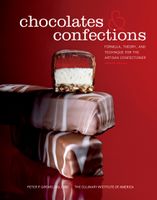Advertisement
Technique: Caveats on Incomplete Melting
Appears in
By Peter Greweling and Culinary Institute of America
Published 2007
Always begin this technique with tempered chocolate so that the seed crystals left behind as the chocolate melts are stable crystals. Previously used chocolate that has set in an untempered state is not acceptable for this method because it will seed the chocolate with unstable crystals.
- As always when melting chocolate, the pieces should be small to ensure even melting without the risk of overheating. Small pieces of chocolate have the additional advantage of cooling and seeding the melted chocolate quickly once it is removed from the heat.
- When using a microwave, take care not to overheat the chocolate. Microwave ovens do not heat evenly, and long exposure without stirring will overheat the chocolate in some areas while leaving it unmelted in others. Always use short intervals in the microwave, and stir between exposures to equalize the temperature.
- Do not warm the chocolate much over 36°C/97°F during melting. Warming the melted chocolate past this temperature will melt all of the chocolate without leaving the requisite seed crystals to temper the chocolate. Should this happen, the chocolate will have to be tempered by another method—either by adding more seeding chocolate or by tabling.
- It is not necessary to cool the chocolate much below 32°C/90°F. A major advantage of incomplete melting is that when performed properly, it introduces only Form-V crystals from the unmelted tempered chocolate. Often during tempering, however, the temperature of the chocolate falls below the desired temperature. If the temperature of the chocolate is too low, or the chocolate is overseeded, or there are unmelted pieces of chocolate remaining in the bowl, the chocolate must be carefully warmed. The chocolate may be warmed over a water bath, flashed on direct heat briefly, or heated in a microwave. Regardless of the method used to warm the chocolate, it must never exceed its maximum working temperature (32°C/90°F for dark chocolate; 30°C/86°F for milk or white chocolate) or the seed crystals will melt and the temper will be lost. After warming chocolate, it should always be tested to verify that it is still in temper.



